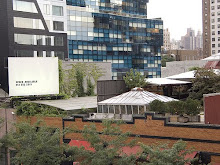


1) Archival Image of Apollo Theater. Posted February 11, 1996. From Correspondent Brian Jenkins.
Address: 253 West 125th Street, New York, NY 10027
Directions: Take the 2, 3 Trains Uptown/Harlem to 125th Street. Walk West 2 Blocks.
A rich Mecca for urban fashion and street culture, 125th street in Harlem is lined with sneaker stores, athletic apparel, boutiques, hair stores, and fast food chains. It is home to the famous Apollo Theatre and has been and urban center for decades. Constructed in 1914 in the heart of Harlem’s 125th street, the Apollo theatre, initially named the Hurtig and Seamon’s New Burlesque Theatre, did not allow African Americans to sit in its audience. However through the Harlem Renaissance and a shift in ownership, the theater underwent a transformation in reputation re-opened as the 125 Street Apollo in 1934. The new owners Frank Schiffman and Leo Brecher partnered with Morris Sussman of the Harlem Opera House
The Theater began to experience a decline in popularity in the 60’s and 70’s and in 1975 it was converted into a movie theater. However, thanks to the Percy E. Sutton, owner of Inner City Broadcasting, the theater was purchased and revived in 1983. Later, in 1975, the Theater received local city, state, and federal recognition for its Landmark Status.
The entire site of 125th Street is one of great importance to African Americans in New York City. It is noted as an epicenter of black community formation--based upon common cultural practices and social struggle--within the city. It is also a symbol of the revival and display of the vibrant African American culture, which ranges from the hip-hop you hear blasting from the stereo systems of cars driving through the streets, to the performances that numerous famous African Americans artists have put on at the Apollo Theater. Race plays a huge role in the popularity of 125th Street, due to the fact that "the racial demography of the places where people live, work, play, shop, and travel exposes them to a socially shared system of exclusion and inclusion" (Lipsitz 12). This Harlem historical site, and specifically the Apollo, relate to the "black spatial imaginary", which describes how people of color, who have been oppressed and relegated to undesirable spaces, have been able to "turn segregation into congregation," and therefore carve out a place for themselves in society (Lipstiz 14). Discourses of space have been ingrained into African American culture, and 125th Street is a prime example of "the celebration of the city street in the imagery and iconography of hip-hop", where the "street" is representative of the overall urban space which the black community has been forced to occupy, and where it now flourishes.
- Stephanie Hurley and Sienna Lee
Sources:
Horton, James Oliver. Landmarks of African American History. New York. Oxford University Press, 2005. Paperback.
Freeman, Lance Ph.D. There goes the ‘hood: views of gentrification from the ground up. Philadelphia, PA. Temple University Press, 2006. Paperback.
Lipsitz, George. The Racialization of Space and the Spatialization of Race; Theorizing the Hidden Architecture of Landscape. Landscape Journal. 26(1): 10-23 (2007).

No comments:
Post a Comment